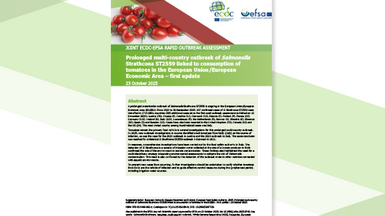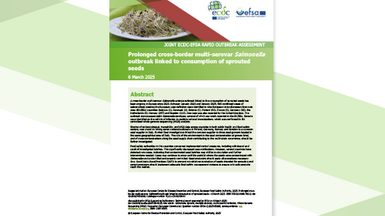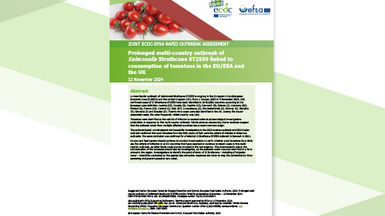Rapid Outbreak Assessment: multi-country foodborne outbreak of Shiga toxin-producing Escherichia coli infections associated with haemolytic uraemic syndrome, 6 April 2016
A multi-country outbreak of Shiga toxin-producing Escherichia coli (STEC) infection associated with haemolytic uraemic syndrome (HUS) and affecting mostly young children has been reported in the last two months in Romania. Italy reported one related HUS case through the Early Warning and Response System (EWRS) on 21 March 2016. Overall, 25 cases were identified as associated with this outbreak, of which 19 developed HUS and three died. Twelve cases had microbiological and/or serological evidence of STEC O26 infection; 13 additional cases met the probable case definition by developing HUS, testing positive for another STEC O serogroup (O157) or by testing positive by PCR for stx1 and/or stx2 and eae genes.
This document assesses the risk to human health posed by a multi-country foodborne outbreak of Shiga toxin-producing Escherichia coli (STEC) infections associated with haemolytic uraemic syndrome taking place in the European Union (EU).
Executive Summary
An outbreak of Shiga toxin-producing Escherichia coli (STEC) infection associated with haemolytic uraemic syndrome (HUS) and affecting mostly young children has been reported in February and March in Romania. Italy reported one HUS case with an epidemiological link to Romania on 21 March 2016.
Overall, 25 cases have been identified as associated with this multi-country outbreak, of which 19 developed HUS and three of these died.
Information collected from patients points towards a milk processing establishment in Romania as a possible source of infection. Several strains of STEC have been identified so far, and it is possible that multiple sources of contamination have contributed to this outbreak.
The recall of suspected food products has been undertaken by food safety authorities in Romania, Italy and other countries who have imported the suspected food items. However, potentially contaminated items could still be present in households. Since the precise source of contamination has not yet been identified, cases possibly linked to the this outbreak may occur in Romania and in those EU countries to which the implicated food products have been distributed.
To minimise the further spread of the infection and investigate possible new cases promptly, ECDC and EFSA recommend EU Member States to consider enhancing monitoring for HUS and STEC cases. In addition, if new cases possibly linked to the outbreak are identified, these should be reported to the Epidemic Intelligence Information System for food- and waterborne diseases (EPIS-FWD).
The investigation of the European dimension of this multi-country foodborne outbreak has demonstrated the added value of collaboration between Romanian and Italian public health and food authorities as well as ECDC and EFSA in enabling appropriate risk assessment and response.







